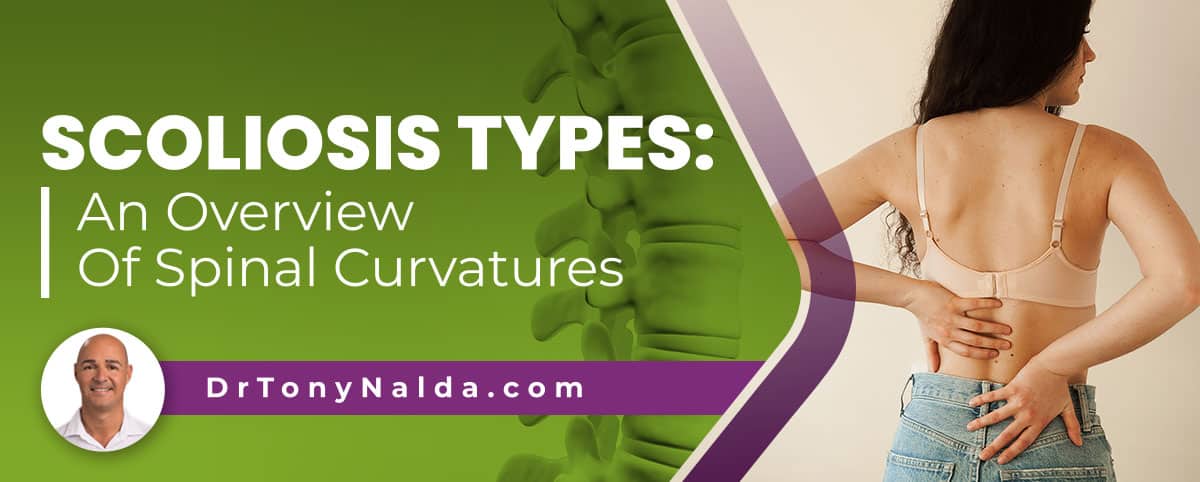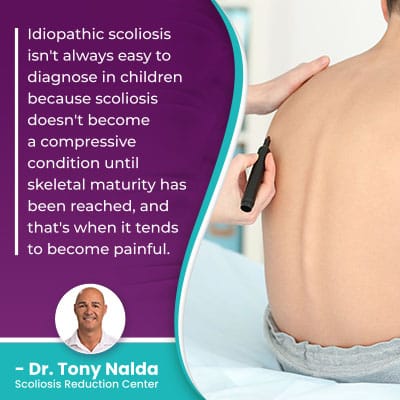Scoliosis Types: An Overview Of Spinal Curvatures

Not only does scoliosis range so widely in severity from mild to moderate and severe to very severe, it affects all ages, can develop anywhere in the spine, and there are also multiple different types that can develop; continue reading to learn about the different forms of scoliosis, with a focus on treatment needs.
When scoliosis is diagnosed, conditions are classified based on key patient/condition variables that treatment plans are designed to address. Condition type is determined by causation, and this includes idiopathic scoliosis, neuromuscular scoliosis, degenerative scoliosis, and congenital scoliosis.
Let's start with how scoliosis is classified as this is when a condition's type is determined.
Table of Contents
Determining Condition Type
When scoliosis is diagnosed, it means an unnatural sideways curvature of the spine has developed that also rotates, making it a complex 3-dimensional condition.
Scoliosis is a highly-prevalent spinal condition, and as the leading spinal condition among school-aged children, childhood scoliosis should be treated very seriously and warrants awareness.
Because scoliosis is so highly-variable and no two cases are the same, conditions are further classified to streamline the treatment process and inform the customization of treatment plans.
It's also important to understand that as a progressive condition, scoliosis has it in its nature to get worse over time, and that means that where a scoliosis is at the time of diagnosis isn't always indicative of where it will stay; only proactive treatment can work towards counteracting the condition's progressive nature.
Condition type is important because it's determined by a condition's underlying cause, and in order to treat scoliosis effectively, its underlying cause has to be addressed; otherwise, only symptoms are being addressed, but not their cause: the condition itself.
It's also important for patients to understand that the complex nature of structural scoliosis is beyond the scope of general medical treatment, instead requiring the training and experience of a scoliosis specialist.
When it comes to scoliosis, the most common type to affect both children and adults is idiopathic scoliosis, and the most common type of scoliosis overall is adolescent idiopathic scoliosis, diagnosed between the ages of 10 and 18.
Idiopathic Scoliosis
 Idiopathic scoliosis means not clearly associated with a single-known cause, and this isn't the same as saying there is a complete absence of a cause; in fact, the general consensus is that idiopathic scoliosis is multifactorial.
Idiopathic scoliosis means not clearly associated with a single-known cause, and this isn't the same as saying there is a complete absence of a cause; in fact, the general consensus is that idiopathic scoliosis is multifactorial.
Multifactorial conditions are caused by a number of variables that can vary from patient to patient and/or a certain combination of variables.
The underlying nature of idiopathic scoliosis is structural, so in order to be treated effectively, it has to be impacted on a structural level, and this is worked towards through a curvature reduction.
While we don't know what triggers the initial onset of idiopathic scoliosis, we do know what triggers it to get worse: growth.
Growth and development triggers scoliosis to get worse, and this means the size of the unnatural spinal curve, and the condition's uneven forces are increasing, as are their effects.
Idiopathic scoliosis isn't always easy to diagnose in children because scoliosis doesn't become a compressive condition until skeletal maturity has been reached, and that's when it tends to become painful.
While no one wants to experience pain, it does help us know when something is wrong inside the body, so when mild and effects are subtle, scoliosis can be difficult to recognize in children.
Approximately 80 percent of known diagnosed scoliosis cases are idiopathic scoliosis, and the remaining 20 percent are those associated with known causes: neuromuscular scoliosis, degenerative scoliosis, and congenital scoliosis.
Neuromuscular Scoliosis
Neuromuscular scoliosis is caused by the presence of a larger neuromuscular condition disrupting communication between the brain, the spine's surrounding muscles, nerves, and connective tissues that support the spine.
Conditions such as spina bifida, cerebral palsy, and muscular dystrophy can disrupt the spine's ability to maintain its natural and healthy curves by affecting its strength, function, and the strength and function of the spine's surrounding muscles and connective tissue.
Connective tissue disorders can be serious, and when they are the cause for the development of a scoliotic curve, the underlying neuromuscular condition has to be the focus of treatment, complicating the process.
Degenerative Scoliosis
Degenerative scoliosis affects aging adults and is caused by natural age-related spinal degeneration, and the cumulative effect of certain lifestyle choices can also play a role in the rate and level of age-related spinal degeneration.
As the body ages, it's vulnerable to degenerative changes, as is the spine, and most spinal degeneration starts with the intervertebral discs.
The spine consists of vertebrae (bones) stacked on top of one another, and there is an intervertebral disc that sits between each pair of adjacent vertebrae.
The spinal discs are key structures that perform many essential roles to facilitate spinal flexibility, strength, and function.
The discs combine forces to enable flexible movement, give the spine structure (adjacent vertebrae attach to the disc in between), and act as the spine's shock absorbers.
When a disc starts to degenerate, it can lose height, change shape, and impact the position of nearby vertebrae.
 When it comes to lifestyle choices that can also contribute to the development of degenerative scoliosis, I'm talking about carrying excess weight, leading a sedentary lifestyle, chronic poor posture, excessive consumption of alcohol and/or smoking, and repeatedly lifting heavy objects incorrectly.
When it comes to lifestyle choices that can also contribute to the development of degenerative scoliosis, I'm talking about carrying excess weight, leading a sedentary lifestyle, chronic poor posture, excessive consumption of alcohol and/or smoking, and repeatedly lifting heavy objects incorrectly.
If the spine's degenerative changes have made it unstable, it's that much harder for it to maintain its natural and healthy curves and alignment.
Treatment for degenerative scoliosis has to focus on stabilizing the spine, more so than a significant curvature reduction when treating young patients, preserving spinal function, and pain management.
Congenital Scoliosis
Congenital scoliosis is a rare condition type affecting approximately 1 in 10,000 and is caused by a spinal malformation that occurs as the spine is developing in utero.
Spinal malformations can include one or more vertebral bodies being more triangular in shape, than rectangular, as they should be, and when vertebral bodies fail to form into separate and distinct bones, instead becoming fused together.
Congenital scoliosis patients have to be monitored closely for progression during growth, and also other malformations within the body.
Cases of congenital scoliosis can be treated non-surgically with a combination of casting, when appropriate, and physical therapy, but clearly, the challenges of treating scoliosis in such young patients involves a lot of treatment plan modifications, and sometimes, surgical intervention is recommended.
Conclusion
So idiopathic scoliosis is the most common type of scoliosis to affect all ages, and the most prevalent form of scoliosis overall is adolescent idiopathic scoliosis, diagnosed during adolescence, during which time the stage of puberty involves rapid and unpredictable growth spurts.
Now, in typical forms of idiopathic scoliosis, the scoliotic curve will bend to the right, away from the heart, but in atypical forms, like those associated with known causes, the unnatural curvature of the spine can bend to the left, towards the heart.
When I see a left-bending curvature of the spine, this is a red flag that there is an underlying pathology behind the development of scoliosis, which is atypical.
So different types of scoliosis are associated with different curvature types, and this is also part of classifying the condition.
The types of scoliosis with known causes are considered atypical and include neuromuscular scoliosis, degenerative scoliosis, and congenital scoliosis.
Regardless of severity or type, all forms of scoliosis are progressive, so the condition has it in its nature to get worse over time, and as scoliosis only gets more complex to treat the more it progresses, the best time to start scoliosis is always now.
Here at the Scoliosis Reduction Center, I treat patients with a proactive conservative scoliosis treatment approach that strives to preserve as much natural spinal strength and function as possible, and the best way to achieve this is through a non-surgical treatment approach.
While spinal fusion surgery still has a place in scoliosis treatment, there are some serious potential risks, side effects, and complications that should be considered carefully.
The most common effect of scoliosis in children is postural deviation such as uneven shoulders and hips, and the most common symptom of scoliosis in adults is pain: back pain and pain that radiates into the extremities due to nerve compression.
Even within a single type of scoliosis, there are still so many variables that change from patient to patient, making no two cases the same, and necessitating the full customization of potentially-effective treatment plans.
If you have recently been diagnosed with scoliosis, it's important to be informed on all treatment options available because different treatment approaches shape long-term spinal health, strength, and function differently.
If in need of a diagnosis, treatment guidance, and/or support, don't hesitate to reach out.
Dr. Tony Nalda
DOCTOR OF CHIROPRACTIC
After receiving an undergraduate degree in psychology and his Doctorate of Chiropractic from Life University, Dr. Nalda settled in Celebration, Florida and proceeded to build one of Central Florida’s most successful chiropractic clinics.
His experience with patients suffering from scoliosis, and the confusion and frustration they faced, led him to seek a specialty in scoliosis care. In 2006 he completed his Intensive Care Certification from CLEAR Institute, a leading scoliosis educational and certification center.
About Dr. Tony Nalda
 Ready to explore scoliosis treatment? Contact Us Now
Ready to explore scoliosis treatment? Contact Us Now





